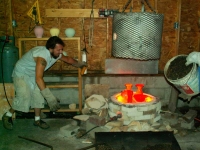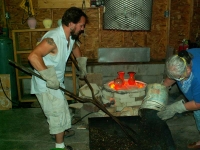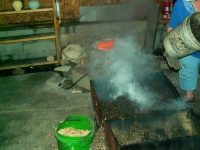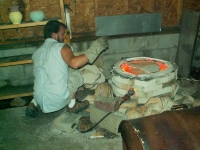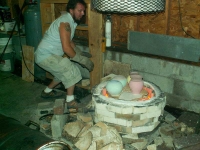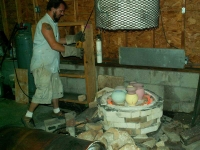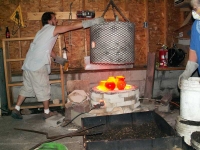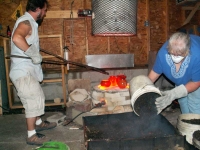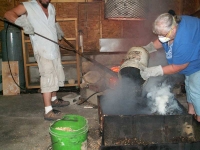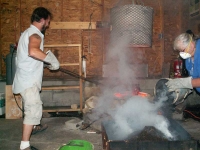
Raku Pottery
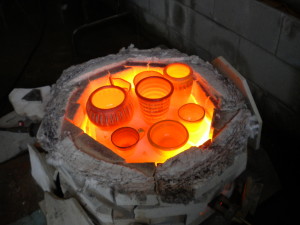
(Excerpt from Wikipedia) “Raku ware (楽焼raku-yaki) is a type of Japanese pottery that is traditionally used in the Japanese tea ceremony, most often in the form of tea bowls. It is traditionally characterized by being hand shaped rather than thrown; fairly porous vessels, which result from low firing temperatures; lead glazes; and the removal of pieces from the kiln while still glowing hot. In the traditional Japanese process, the fired raku piece is removed from the hot kiln and is allowed to cool in the open air or in a container filled with combustible material. Raku techniques have been modified by contemporary potters worldwide.”
When we Raku fire our pottery pieces, local artist Jack Valentine runs the kiln, and I pour the sawdust and clean the carbon off the pieces. We fire in a propane-fueled kiln until the pieces are visually ready to remove (once the glazes have smoothed out over the pieces and have a glassy sheen). The temperature is about 1900-2000 degrees at this point. The kiln body is raised using a pulley system, and the pieces are quickly transferred from the kiln to a split, hinged barrel filled with sawdust. More sawdust is poured over the red, glowing pieces, and the sawdust bursts into flames. The object is to cover the piece quickly and completely. The lid is then closed over the barrel and the pieces are left in the smoldering sawdust for about 20 minutes to half an hour while another load is being fired. This is called the reduction process in which the pottery piece is exposed to an atmosphere that does not have enough oxygen to consume the fuel (sawdust) as it burns.
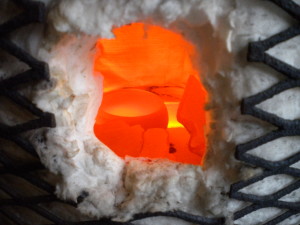
The process pulls oxygen out of the clay body and glaze and causes carbon to be pulled into the white clay body. Unglazed surfaces then become matte black due to the carbon. The glazes I use have either the ability to crackle (causing the crazing to be filled with carbon) or flash bright metallics in a rainbow of colors ranging from rich purples to bright copper.
The results are often unpredictable. There are many variables that change the finish on a pot. The temperature outside, the humidity, the position in the kiln, the length of time between pulling a pot from the kiln and placing in sawdust then covering it with sawdust all have a hand at what the final product will be.
As pots begin to cool, they are pulled from the sawdust and are covered in soot and carbon that has to be cleaned off. The metallic or crackle peeks through the buildup on the outside of the pot and gives a glimpse of what the finished pottery piece will look like. Each piece is then meticulously scrubbed with steel wool and pumice soap, then buffed with a terry towel. It is not until it is completely clean that each piece’s character and beauty is discovered.
The process happens over and over in a firing session. It is not unusual for our firing sessions to be 6 to 10 hours in a day. A load goes in the kiln, is pulled and placed in the reduction barrel, another load is placed in the kiln. The pots are cooled and cleaned, as another load is firing. And so on. At the end of the day, the result is dozens of new and intriguing artistic pottery pieces ready for sale in galleries and shows.
The clay used for raku, like the glazes, is specifically designed for the raku firing process. I use a white stoneware with medium to heavy grog. It is formulated to withstand the rapid rise in temperature and the thermal shock of being pulled from the kiln and drenched in sawdust. Very rarely do we lose a piece to breakage, thanks to the expertise of Jack Valentine, who has been running the raku kiln for over 20 years.
For a chance to participate in this dramatic firing technique, Jack Valentine has a 3-day open house each September where visitors can choose a bisque-fired pottery piece, glaze it and help Jack during the firing and reduction of their pieces. The Valentine Studio Open House for 2014 is September 26 through 28 at his studio at 1849 Pickle Road, Springfield Township. To learn more about this wonderful event go to valentine-studios.com.
Over the years we have raku-fired our pottery in 14-degree F temperatures with snow outside, and on days when it’s 95 degrees F and 100% humidity. It is labor intensive, hot and smelly, but when the day is done, and the pottery is placed on the table to view, it is obvious it is a labor of love.

